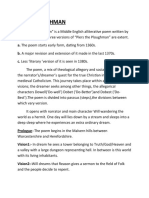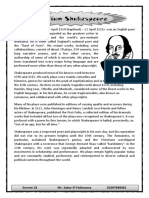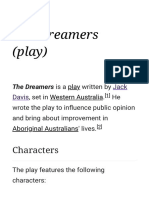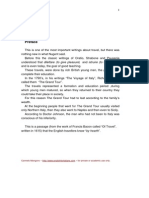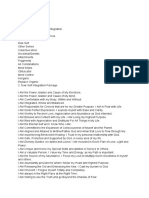0 ratings0% found this document useful (0 votes)
317 viewsThe Development of English Drama
The Development of English Drama
Uploaded by
marrylfa ham- English drama originated from religious dramas performed in churches starting in the 10th century. These early dramas were known as liturgical dramas.
- Between the 13th-16th centuries, religious dramas known as Miracle Plays became popular and began to be performed outside of churches by guilds. These plays depicted stories from the Bible and lives of saints.
- The rise of Morality Plays in this period saw the introduction of allegorical figures representing virtues and vices in didactic performances meant to provide moral lessons.
- By the 16th century, English drama evolved into more artistic, secular forms under classical influences, including the first recorded English comedy "Ralph
Copyright:
© All Rights Reserved
Available Formats
Download as DOCX, PDF, TXT or read online from Scribd
The Development of English Drama
The Development of English Drama
Uploaded by
marrylfa ham0 ratings0% found this document useful (0 votes)
317 views6 pages- English drama originated from religious dramas performed in churches starting in the 10th century. These early dramas were known as liturgical dramas.
- Between the 13th-16th centuries, religious dramas known as Miracle Plays became popular and began to be performed outside of churches by guilds. These plays depicted stories from the Bible and lives of saints.
- The rise of Morality Plays in this period saw the introduction of allegorical figures representing virtues and vices in didactic performances meant to provide moral lessons.
- By the 16th century, English drama evolved into more artistic, secular forms under classical influences, including the first recorded English comedy "Ralph
Original Description:
english drama
Copyright
© © All Rights Reserved
Available Formats
DOCX, PDF, TXT or read online from Scribd
Share this document
Did you find this document useful?
Is this content inappropriate?
- English drama originated from religious dramas performed in churches starting in the 10th century. These early dramas were known as liturgical dramas.
- Between the 13th-16th centuries, religious dramas known as Miracle Plays became popular and began to be performed outside of churches by guilds. These plays depicted stories from the Bible and lives of saints.
- The rise of Morality Plays in this period saw the introduction of allegorical figures representing virtues and vices in didactic performances meant to provide moral lessons.
- By the 16th century, English drama evolved into more artistic, secular forms under classical influences, including the first recorded English comedy "Ralph
Copyright:
© All Rights Reserved
Available Formats
Download as DOCX, PDF, TXT or read online from Scribd
Download as docx, pdf, or txt
0 ratings0% found this document useful (0 votes)
317 views6 pagesThe Development of English Drama
The Development of English Drama
Uploaded by
marrylfa ham- English drama originated from religious dramas performed in churches starting in the 10th century. These early dramas were known as liturgical dramas.
- Between the 13th-16th centuries, religious dramas known as Miracle Plays became popular and began to be performed outside of churches by guilds. These plays depicted stories from the Bible and lives of saints.
- The rise of Morality Plays in this period saw the introduction of allegorical figures representing virtues and vices in didactic performances meant to provide moral lessons.
- By the 16th century, English drama evolved into more artistic, secular forms under classical influences, including the first recorded English comedy "Ralph
Copyright:
© All Rights Reserved
Available Formats
Download as DOCX, PDF, TXT or read online from Scribd
Download as docx, pdf, or txt
You are on page 1of 6
THE DEVELOPMENT OF English Drama
The origin of English drama seems vague. There is no certain
evidence proving its origin. However, it can be traced back from
century of succeeding Norman Conquest to England on 1066. Many
historians believe that drama came to England along with them. There
was information that when the Roman where in England, they
established vast amphitheatre for production some plays, but when
they left, the theatre gone with them
------Drama came along Norman Conquest 1066-----
Originally, the term drama came from Greek word meaning “action” or
“to act” or “to do”. William J. Long argues that “drama is an old story
told in the eye, a story put into action by living performers”. Thus,
drama is the form of composition design for performance in the
theatre, in which the actors take role for certain characters, perform
certain action and utter certain dialogues (Abrams and Harpham,
2015:95).
-------Drama = Action {drama is a story told in the eye and then be
performed}------
In England, drama had a distinctly religious origin from the church as
the part of services. Apart from its origin, the Latin Church had
condemned Roman theatre for many reasons. Thus, drama could not
develop until tenth century when the church began to use dramatic
elements as part of their services in the certain festival or ritual. The
motives of the church began to use dramatics elements seem unclear.
But, it was certain that the purpose was didactic, that is, to give deep
understanding about the truth of their religion to the believer
------drama developed in the 10th century when the church began to
use drama as the the part of their festival/ritual-----
The oldest existing church drama was “Quem Quarritis” trope (whom
are you seeking), when the three Marrys visited the empty tomb of
Christ and met angel. Their conversation with angel consists of four
sentences in Latin then adapted and performed by the clergy in very
simple performance. This simple beginning gradually grew more
elaborate. This drama called liturgical drama, in which the story simply
taken from the scripture. The earlier play were given inside the church,
the story were written by the clergy and performed by the clergy using
Latin language. However, drama were not performed in all churches,
only in certain cathedrals and monasteries where there were enough
clergy to perform the plays.
-----The oldest existing church drama “Quem Quarritis” (Whom You
are seeking) which is spoken in Latin. It categorize as Liturgical
Drama-----
From the liturgical, drama evolved to Miracle and Mystery play. In
France, Miracle used to represent the life of the saints and Mystery
used to represent any scene taken from the scripture. Meanwhile in
England, there was no distinction between this two. The term Miracle
play was used to represent any story taken from the scripture or the
bible and the life of the saints.
------In Literugical, there are divided into two kinds of play which are
Miracle and Mystery. In Franse Miracle(life of saints) and
Mystery(any scene from Scripture). But I=in England Miracle
represent the combination of them which is any story from scripture
and the life of saints
The earliest recorded Miracle play in England was “Ludus Santa de
Katherina”, which performed in Dunstable around 11110. It was not
known who wrote the original play, but the first version was prepared
by the French school teacher, Geoffrey from St. Albans. The plays
were given in Latin or French. The Miracle play attracted so many
people and increased its popularity. The plays were before given
inside the church began to move to the porch then to the churchyards.
But when the plays began interfere the church services and had
become too elaborate, the scandalized priest forbade the play in the
church. By the thirteenth century, the Miracle play began move
outside the church.
---- the earliest recorded play was “ Ludus Santa De Katherina 1110”
anonymous. In 13th c Miracle play began move outside the church.----
After the Miracle play move outside the church, the secular
organization or town guilds began to take responsibility in its
production. Few changes were made during this period. By the
fourteenth and fifteenth century, the plays were given in vernacular pr
local language. The actors were no longer clergy but the amateur
actors which trained and selected carefully. The plays were given in
the series of mansion in the town square. The plays were performed o
moving platform called pageants and the act area called pletea. The
stage were divide into three parts; hell, earth and heaven. Hell in the
left side, earth in the centre and heaven in the right side. Usually the
stages were identified by certain props. For instance, the head of
dragon with red jaws or monstrous mouth with fire breathing represent
hell where the devil characters will be dragged to the hell. The idea of
salvation and damnation which later adopted in Dr. Faustus was
inherited from this period. The costumes were distinguish in three
realms; heaven, earth and hell. The heavenly characters such as God,
angels, saints or certain Biblical character wore the church garments
with certain accessories. The earthly characters wore the
contemporary medieval garment appropriate to their rank. Meanwhile,
for devil character wore black garments with wings, animals claws,
beaks, horns or tails.
-----Secular organization began to take responsibility in its production
so in 13th and 14th c it was in the local lang. the stage were divided into
three parts; hell, earth and heaven (Left side, center, Right side)----
On 1311, the Council of Vienne revived the feat of Corpus Christi. This
festival held in June every year and last for three or four days,
sometimes extend to six days. The Miracle plays were presented in all
large town city in England. It was arranged to exhibit the whole story
from creation to the Day of Judgment in a cycle. There were four
famous cycle existed in England. The York with 48 plays, the Chester
with 25 plays, the Wakefield with 32 plays and the Coventry with 42
plays. During this religious period drama were written according to the
Bible and no change was tolerated. This religious performances lasted
till the sixteenth century.
-----In the 13th-16th c drama performed according to the bible and no
change was tolerated.-----
The later development of drama was Morality play. it is a
dramatization of personified abstraction generally vice against virtue.
In these plays, the character were allegorical personified such as
death, sin, good and bad angel, seven deadly sins, etc. The purpose
of this drama was didactic, to give moral lesson to the audience. The
morality plays generally ended with the virtue win against the evil. This
play was marked by the introduction of personage called “vice”, who
was mischievous, comic and humorous character. Vice was the
predecessor of the modern clown or jester. The examples of morality
plays are “Everyman” and “The Castle of Perseverance”. The
introduction of Morality play also introduce so called “interlude”.
Interlude is the short version of morality play. Generally interludes
were given during break of the scene. It was a short stage
entertainment in a sense of humor and was considered as the
forerunner of comedies. The example of interlude was “The Four P’s”
by John Heywood which performed around 1497.
----- The morality play provided sin, good and bad angel, seven deadly
angel, etc. the purpose was didactic, to give moral lesson to the
audiens. It generally ended with the virtue win against the devil. Then
there was also an “Interlude” which is a short morality play, performed
during break of the scene.------
The final stage of the evolution of English drama was the artistic
period. In this period, the purpose of the pay was not to point out a
moral but to represent human life as it is. During this period, English
drama was influenced by classical drama. The first comedy was
“Ralph Roister Doister” written by Nicholas Udall on 1556. The play
divided into acts and scenes and wrote in rhyming couplets. This first
comedy had become the model and predecessor of English comedies.
The first tragedy “Gorboduc” was written by Thomas Sackville and
Thomas Northon around 1562. It was written in blank verse and
divided into acts and scenes. After this era, the English drama
developed gradually into regular form of drama which flourish during
Elizabethan reign and which known till today.
----the final stage of the evolution of English Drama,The Artistic period,
drama performed to represent human as it is. It is influenced by
classical drama.----
^The First comedy was “ Ralph Roister Doister” written by Nicholas
Udall on 1556^
^The First Tragedy was “Gorbuduc” written by Thomas Sackville and
Thomas Norton c. 1562^
Therefore, English drama gradually develop from the liturgical drama
to Miracle and Mystery plays, continuously to Morality and interlude
followed by the influence of classical model and finally evolve to the
regular drama forms which known till today.
Liturgical Drama—Miracle and Mystery Drama—Morality and
Interlude Drama—todays drama.<--
You might also like
- Kings and Queens of England Episode 1 NormansDocument4 pagesKings and Queens of England Episode 1 NormansDragaica Alexandru100% (3)
- Death Theme in LiteratureDocument3 pagesDeath Theme in Literaturemterrano0% (1)
- Had - Anhad (The Kabir Project)Document3 pagesHad - Anhad (The Kabir Project)Tom Riddle100% (3)
- ShivyogDocument55 pagesShivyogReeshabhdev Gauttam100% (1)
- The Origin and Development of English Drama in England: by DR Madhulika Sinha Govt. Bilasa Girl's PG College, BilaspurDocument24 pagesThe Origin and Development of English Drama in England: by DR Madhulika Sinha Govt. Bilasa Girl's PG College, BilaspurDiana Rose BermilloNo ratings yet
- Restoration Comedy: Three Plays: Full Text and Introduction (NHB Drama Classics)From EverandRestoration Comedy: Three Plays: Full Text and Introduction (NHB Drama Classics)No ratings yet
- Neoclassic and RomanticDocument6 pagesNeoclassic and Romantic008164995No ratings yet
- DRAMA B.A 3rd Sem Different Kinds of Drama Not Immp NowDocument33 pagesDRAMA B.A 3rd Sem Different Kinds of Drama Not Immp NowrameenNo ratings yet
- Renaissance DramaDocument36 pagesRenaissance DramaAmalia Ramírez AranaNo ratings yet
- The TempestDocument7 pagesThe Tempestannalisa.stipNo ratings yet
- The Novel of Manners Samuel RichardsonDocument9 pagesThe Novel of Manners Samuel RichardsonAmalia BodeaNo ratings yet
- Revenge TragedyDocument1 pageRevenge TragedyRaihan AliNo ratings yet
- Origin and Growth of British Drama Upto Yeats Sec-BDocument138 pagesOrigin and Growth of British Drama Upto Yeats Sec-BShruti SinghNo ratings yet
- THE AGE OF CHAUCER (1350-1400) and His Contemporaries By: Shireen Bilgrami Background of The 14 CenturyDocument3 pagesTHE AGE OF CHAUCER (1350-1400) and His Contemporaries By: Shireen Bilgrami Background of The 14 Centurybushra mumtazNo ratings yet
- Geoffrey Chaucer Biography: Quick FactsDocument5 pagesGeoffrey Chaucer Biography: Quick FactsJesnataNo ratings yet
- ThemesDocument9 pagesThemesyousefsalman221100% (1)
- Evolution Theory African Dramatic LiteraDocument15 pagesEvolution Theory African Dramatic LiteraAkpevweOghene PeaceNo ratings yet
- Piers The PlowmanDocument4 pagesPiers The Plowmansudipto paulNo ratings yet
- The Classical and Neoclassical ConceptDocument4 pagesThe Classical and Neoclassical ConceptSunaina Guglani - WattsNo ratings yet
- ComedyDocument3 pagesComedyali purityNo ratings yet
- Elizabethan Paper3Document13 pagesElizabethan Paper3CreatnestNo ratings yet
- Philip Larkin's Concept of Time As Projected in His Poetry: A Brief AnalysisDocument5 pagesPhilip Larkin's Concept of Time As Projected in His Poetry: A Brief AnalysisNethuli KiaraNo ratings yet
- English Prose in RenaissanceDocument2 pagesEnglish Prose in RenaissanceMuhammad YahyaNo ratings yet
- Christopher Marlowe TamburlaineDocument3 pagesChristopher Marlowe TamburlainedfdfNo ratings yet
- Past Paper of Criticism 2004 To 2019Document28 pagesPast Paper of Criticism 2004 To 2019Noor UlainNo ratings yet
- Alexander PopeDocument2 pagesAlexander Popenatura200No ratings yet
- Ophelia HandoutDocument4 pagesOphelia HandoutLeilyn Mae AbellarNo ratings yet
- The Age of MiltonDocument7 pagesThe Age of Miltonalexiz_jonesNo ratings yet
- Sidney PoemsDocument10 pagesSidney PoemsChikev97No ratings yet
- The Age of PopeDocument4 pagesThe Age of PopeAhsan ullah SalarNo ratings yet
- Cavalier Poet - WikipediaDocument4 pagesCavalier Poet - Wikipediasa46851No ratings yet
- William Shakespeare (26 April 1564 (Baptised) - 23 April 1616) Was An English PoetDocument6 pagesWilliam Shakespeare (26 April 1564 (Baptised) - 23 April 1616) Was An English PoetHany FaroukNo ratings yet
- AlchemistDocument2 pagesAlchemistDavid HombalNo ratings yet
- The Main Characteristics of One-Act PlayDocument3 pagesThe Main Characteristics of One-Act PlayMuhammad Furqan Aslam Awan100% (1)
- History of Anglo Saxon Literature English Assignment NUML National University of Modern LanguagesDocument15 pagesHistory of Anglo Saxon Literature English Assignment NUML National University of Modern LanguagesMaanNo ratings yet
- The PlaywrightDocument3 pagesThe PlaywrightZoheb BogaNo ratings yet
- Sonnet 60 by William ShakespeareDocument2 pagesSonnet 60 by William ShakespeareEsther MorónNo ratings yet
- Poetics by AristotleDocument8 pagesPoetics by AristotleAmmi KhanNo ratings yet
- Themes in Shakespearean TragediesDocument2 pagesThemes in Shakespearean TragediesArshad MunirNo ratings yet
- Syllabus For BCS (Written) Examination 47Document10 pagesSyllabus For BCS (Written) Examination 47ABC CODCUCT0% (2)
- A&a CC3Document29 pagesA&a CC3Asmita BasakNo ratings yet
- The Restoration Period (1660-1700) : The Important Facts Which Influenced The Literature of This Period AreDocument6 pagesThe Restoration Period (1660-1700) : The Important Facts Which Influenced The Literature of This Period AreKiều TrinhNo ratings yet
- Accent and DialectDocument13 pagesAccent and DialectJeniven DancalanNo ratings yet
- The Dream ChildrenDocument10 pagesThe Dream ChildrenAditya SonuNo ratings yet
- The Dreamers (Play) - WikipediaDocument5 pagesThe Dreamers (Play) - WikipediaZareesh KhanNo ratings yet
- What Is Literature?: R.J. Rees, R.A. Scott-James, Terry Vargas LlosaDocument21 pagesWhat Is Literature?: R.J. Rees, R.A. Scott-James, Terry Vargas LlosaQhusnul AmaliaNo ratings yet
- Volpone - Wikipedia PDFDocument28 pagesVolpone - Wikipedia PDFRIYAS AHAMEDNo ratings yet
- TragedyDocument3 pagesTragedySONA100% (1)
- William Shakespeare's Life and His AchievementsDocument2 pagesWilliam Shakespeare's Life and His AchievementsSagar ThakerNo ratings yet
- The Rape of The LockDocument30 pagesThe Rape of The LockTasnim Azam MoumiNo ratings yet
- A SCHOOL FOR SCANDAL by RICHARD BRINSLEY SHERIDANDocument1 pageA SCHOOL FOR SCANDAL by RICHARD BRINSLEY SHERIDANAyça GöçerNo ratings yet
- Henry Fielding's Comic Epic in Prose: A Study of Joseph Andrews in The Light of This GenreDocument3 pagesHenry Fielding's Comic Epic in Prose: A Study of Joseph Andrews in The Light of This GenreAli AL MalkyNo ratings yet
- Islam and TamburlaineDocument9 pagesIslam and TamburlaineFarange AnjeliaNo ratings yet
- A Dialogue of Self and SoulDocument4 pagesA Dialogue of Self and SoulAwais TareqNo ratings yet
- Forms of DramaDocument2 pagesForms of Dramaarshad tararNo ratings yet
- Components of Drama and Oedipus Rex As ExampleDocument3 pagesComponents of Drama and Oedipus Rex As ExampleAmir Khan VlogsNo ratings yet
- English ProjectDocument13 pagesEnglish Projectরবিন মজুমদার100% (1)
- Francis Bacon - of TravelDocument2 pagesFrancis Bacon - of TravelSitesh Sil100% (1)
- Definition and Explanation of Adjective PhrasesDocument37 pagesDefinition and Explanation of Adjective PhrasessaminceNo ratings yet
- Portrayal of Restoration Women in TDocument6 pagesPortrayal of Restoration Women in TSaatvika Maulihar BA p 1stNo ratings yet
- Assigment On Samuel Taylor ColeridgeDocument4 pagesAssigment On Samuel Taylor ColeridgeArbab UmarNo ratings yet
- Jacobean DramaDocument7 pagesJacobean DramaMaliha Soori50% (2)
- Metaphisical AgeDocument6 pagesMetaphisical AgeDavid KhanNo ratings yet
- 10 Sanskars To Remove Mantra DoshaDocument3 pages10 Sanskars To Remove Mantra DoshaRakesh Singh100% (1)
- Hellenism Vs ChristianityDocument10 pagesHellenism Vs ChristianitymjariaNo ratings yet
- WholismDocument8 pagesWholismDayal nitaiNo ratings yet
- Yoga AsanasDocument170 pagesYoga AsanasKartik Vashishta100% (3)
- NOH Volume 1 CMPLTDocument380 pagesNOH Volume 1 CMPLTJIACK100% (3)
- Simplifiededition: For Those Loving Jehovah, "There Is No Stumbling Block"Document32 pagesSimplifiededition: For Those Loving Jehovah, "There Is No Stumbling Block"marlenyhernandez062254No ratings yet
- The Lovely BonesDocument4 pagesThe Lovely Bonesalzysam25% (4)
- Pope John Paul II (Laborem Exercens)Document25 pagesPope John Paul II (Laborem Exercens)JessaMangadlaoNo ratings yet
- Miller The Bahai Faith Its History and TeachingsDocument371 pagesMiller The Bahai Faith Its History and TeachingsWahid AzalNo ratings yet
- The Blessings of The TempleDocument4 pagesThe Blessings of The TempleDiane PritchettNo ratings yet
- Arabic in HindiDocument18 pagesArabic in HindinunoNo ratings yet
- Rashi On Joshua - en - The Book of Joshua, Metsudah Publications, 1997.plainDocument63 pagesRashi On Joshua - en - The Book of Joshua, Metsudah Publications, 1997.plainnestorsouza36No ratings yet
- PDF Key Extracts - Act 2Document15 pagesPDF Key Extracts - Act 2Cerys WarwickNo ratings yet
- SR5 TOOL Critter Power List, Compiled (B4 Version)Document2 pagesSR5 TOOL Critter Power List, Compiled (B4 Version)Beki LokaNo ratings yet
- Ghazali CausalityDocument25 pagesGhazali CausalitySo' FineNo ratings yet
- Project Dayan PrathaDocument29 pagesProject Dayan PrathaSHREYA KUMARINo ratings yet
- The Telluric BreathingDocument7 pagesThe Telluric BreathingRebeccaLangford100% (1)
- Workers Vanguard No 518 - 18 January 1991Document16 pagesWorkers Vanguard No 518 - 18 January 1991Workers VanguardNo ratings yet
- CRE QUESTIONS AND ANSWERS F1-F4Document189 pagesCRE QUESTIONS AND ANSWERS F1-F4Muthoni WachiraNo ratings yet
- From Vision To System Finishing The TaskDocument29 pagesFrom Vision To System Finishing The TaskHassan Jacob AguimesheoNo ratings yet
- M1-13876 - St. John's Magazine Summer 2023 CURRENTDocument35 pagesM1-13876 - St. John's Magazine Summer 2023 CURRENTSt Johns UniversityNo ratings yet
- 591 TheWayofKolinahDocument107 pages591 TheWayofKolinahDevNo ratings yet
- Common Citation Problems To Watch For in Student PapersDocument3 pagesCommon Citation Problems To Watch For in Student PapersMichael LoftonNo ratings yet
- Robinson - Crusoe-Daniel - Defoe - WooEnglishDocument26 pagesRobinson - Crusoe-Daniel - Defoe - WooEnglishCatherine PhyuNo ratings yet
- The Alliance WeeklyDocument16 pagesThe Alliance WeeklypunciNo ratings yet
- Taoism - An Eastern Approach To Positive psychology-ARYA K RAVI-PG19024Document15 pagesTaoism - An Eastern Approach To Positive psychology-ARYA K RAVI-PG19024Arya RaviNo ratings yet
- Now Self Affirmations For IntegrationDocument3 pagesNow Self Affirmations For IntegrationstefNo ratings yet

















